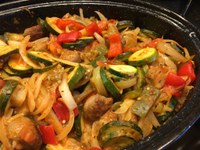Prairie Fare: Savor the Flavor of Eating Right
(Click an image below to view a high-resolution image that can be downloaded)
By Julie Garden-Robinson, Food and Nutrition Specialist
NDSU Extension Service
When I opened the front door of our home one day, my nose detected a wonderful aroma. I knew my husband had a food preparation “project” in progress and our family would be the delighted recipients.
He had made homemade pastrami. The process involved brining the beef, applying a rub, smoking it on the grill for many hours, and pressure-cooking the end product.
Yes, that was a lot of work. However, he had an appreciative family who enjoyed the Reuben-style panini sandwiches made from the “meat” of his labors.
It definitely was better than the store-bought kind. He had to shoo me away from the pieces of pastrami on the cutting board.
He used a flavorful rub that included black pepper, coriander and mustard seeds. Some recipes also include garlic, paprika and allspice. We all hope he makes a larger batch next time.
Although I would like to say that nutrition is the main reason people choose the foods they do, flavor trumps nutrition. However, good nutrition and good flavor do not have to be exclusive of each other.
During March, which is designated National Nutrition Month by the Academy of Nutrition and Dietetics, we are encouraged to savor the flavor of eating right.
If you are like many people, you have a collection of spices or dried herbs. Maybe you bought some for a recipe you made one or two times, and now the bottle stands in your cupboard waiting for some attention.
Are herbs and spices the same? Technically, herbs and spices are different things. Herbs are leaves from low-growing shrubs. Herbs include parsley, chives, thyme, basil, dill, rosemary and sage.
Spices are from plant material other than leaves. Spices may be from bark (cinnamon), buds (cloves), roots (ginger, onion, garlic) and seeds (mustard seeds).
You can add extra flavor with herbs and spices when you cook. You can leave out the salt and use spices and herbs to cut the sodium.
Put your herbs and spices to use in new ways. Check out the herb and spice guides in the cookbooks you probably have tucked in your cupboard. A pinch of dill can add some pizzazz to cooked green beans, fish, salmon or scrambled eggs.
Besides adding a savory flavor, you can enhance naturally sweet-flavored foods (such as fruit) by adding cinnamon, cloves, ginger or nutmeg. Try a sprinkle of one or more of these spices on baked apples or a mixed fruit salad.
Visit http://www.whatscooking.fns.usda.gov/ and search by spice name to find a variety of recipes to try.
To keep your herbs and spices at their best, store them in a tightly covered container in a cool, dry place. Keep them away from heat sources such as a dishwasher or stove.
On most Sunday afternoons, the “Robinson Cooking and Tasting School” is in session with at least a couple of my kids. We recently tried a Mediterranean-inspired stew. Although I usually do not include recipes with this many ingredients, this colorful and flavorful stew was worth all the peeling and chopping. We served it with crusty garlic bread and milk.
Mediterranean Stew
1 pound mild Italian sausage (meatballs or large links, cut)
1 large eggplant, peeled and cubed
4 small zucchini, cut into 1/2-inch slices
1 large green bell pepper, seeded and cut into chunks
2 large red bell peppers, seeded and cut into chunks
1/2 c. flour
2 medium onions, sliced
2 cloves garlic, minced
4 Tbsp. olive oil
4 large tomatoes, peeled, seeded and cut into chunks
1 (15-ounce) can chunky style tomato sauce
1/2 c. red wine (or substitute broth or water)
1 tsp. dried oregano leaves
1 tsp. dried basil leaves
1/4 tsp. salt
1/4 tsp. pepper
1 small bay leaf (remove before serving)
1/2 c. shredded cheddar cheese
Heat oven to 350 F. If using large Italian sausage links (often sold with brats in the meat section), cut them into 1-inch chunks and brown in a nonstick pan. As an alternate, make small meatballs from Italian sausage and bake until cooked throughout. Dredge eggplant, zucchini and peppers in flour. In large skillet, heat olive oil; saute floured vegetables in small batches just until lightly browned. Add more oil if necessary. Remove vegetables; drain on paper towels. Saute onions and garlic in same skillet.
In large roaster, combine sausage and vegetables. In small saucepan, combine tomato sauce and wine; add seasonings. Heat just to simmer. Continue simmering for a few minutes to blend flavors. Pour over ingredients in roaster. Cover. Bake about 60 minutes. Place in bowls and sprinkle with cheese if desired.
Makes 10 servings. Each serving has 350 calories, 19 grams (g) fat, 12 g protein, 20 g carbohydrate, 5 g fiber and 640 milligrams sodium.
(Julie Garden-Robinson, Ph.D., R.D., L.R.D., is a North Dakota State University Extension Service food and nutrition specialist and professor in the Department of Health, Nutrition and Exercise Sciences.)
NDSU Agriculture Communication - March 3, 2016
| Source: | Julie Garden-Robinson, (701) 231-7187, julie.garden-robinson@ndsu.edu |
|---|---|
| Editor: | Ellen Crawford, (701) 231-5391, ellen.crawford@ndsu.edu |



